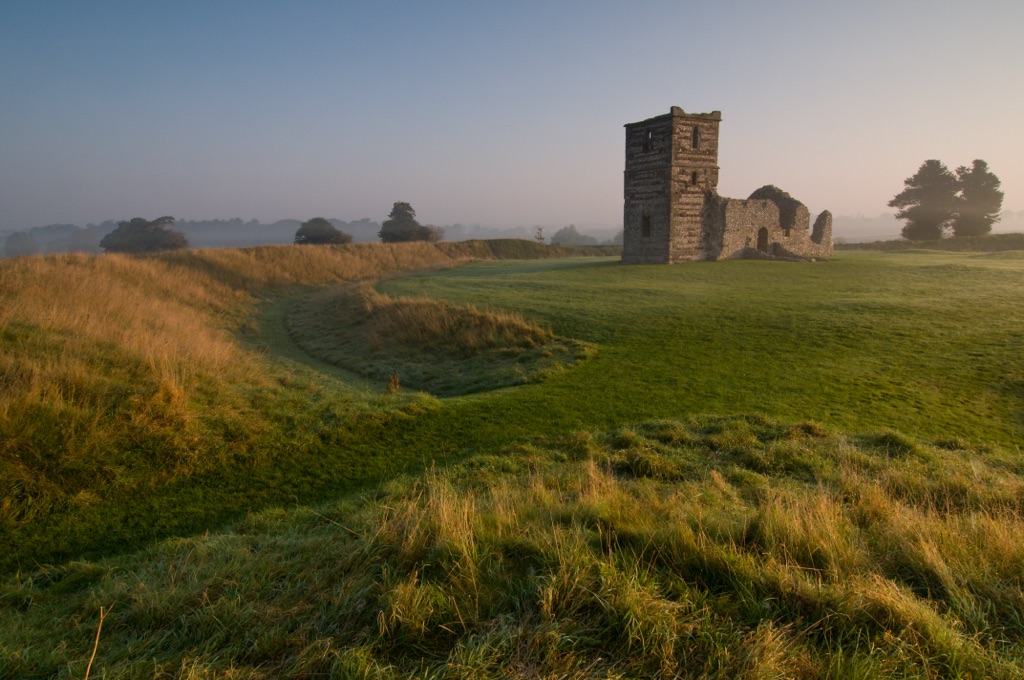Nestled in the lush Dorset countryside lies Knowlton Church and Earthworks, a site steeped in history and mystery. This ancient place comprises the ruins of a Norman church at the center of a Neolithic henge, creating a unique blend of Christian and pagan landscapes. The earthworks, which are older than the church, hint at the site’s long-standing spiritual significance. The church, now a haunting shell, stands as a testament to the religious transformations that have swept across England over the centuries.
Get your dose of History via Email
Historical Background of Knowlton Church and Earthworks
The story of Knowlton Church and Earthworks begins in the Neolithic period, around 2500 BC. The site features a henge, a circular earthwork consisting of a ditch and bank, which predates the church by thousands of years. The henge is part of a larger complex of Neolithic and Bronze Age monuments in the area, suggesting its importance in prehistoric times. The Normans built the church in the 12th century, incorporating it within the pre-existing henge. This unusual configuration indicates the site’s continued spiritual significance.
Archaeologists discovered the site’s significance in the 19th century, although locals had long known about it. Sir Richard Colt Hoare, a notable antiquarian, documented the earthworks in the early 1800s. The church’s builders remain unknown, but it is typical of Norman ecclesiastical architecture. Over the centuries, the church underwent modifications until its abandonment in the 17th century.
The site has seen various inhabitants and uses over the millennia. During the Roman occupation of Britain, there is evidence of Roman activity at the site. The church served the local community until the Black Death and later religious changes led to its decline. It was not the scene of any major historical events but is significant for its continuous use over such a long period.
Knowlton Church and Earthworks stand out for their combination of ancient and medieval history. The church’s construction within a prehistoric henge is rare in England. This suggests a deliberate connection between the Christian church and the older pagan traditions. The site’s abandonment adds to its air of mystery, leaving behind a haunting monument to England’s spiritual past.
The church’s ruins and the earthworks have become a focal point for local folklore and legend. They have also attracted the attention of historians and archaeologists interested in the transition from paganism to Christianity. The site remains a poignant reminder of England’s layered history, with each era leaving its mark on the landscape.
About Knowlton Church and Earthworks
Knowlton Church, formally known as the Church of St. Mary, is a Norman structure built in the 12th century. Its flint and stone walls, now partially collapsed, once housed a nave, chancel, and central tower. The church’s design reflects the Romanesque style, with characteristic rounded arches and massive stonework. The earthworks surrounding the church are much older, dating back to the Neolithic period.
The construction methods of the church were typical of the Norman period. Builders used local flint and rubble, bound with lime mortar, to erect the walls. The church’s original roof has long since disappeared, leaving the sky as its canopy. The earthworks consist of a circular bank and internal ditch, forming a henge that encircles the church.
Architectural highlights of the church include the surviving arches and the layout of the nave. The earthworks are notable for their size and the precision with which they were constructed. The henge’s diameter measures approximately 220 meters, making it one of the larger examples in Britain.
Over the years, the church has deteriorated due to weathering and neglect. However, the remaining structure provides valuable insights into Norman ecclesiastical architecture. The earthworks, too, have suffered from erosion but remain a prominent feature of the landscape. Together, they offer a glimpse into the past, both architecturally and archaeologically.
The site’s building materials and construction techniques reflect the resources and knowledge available at the time. The combination of the church and earthworks illustrates the melding of cultural influences over thousands of years. This blend of ancient and medieval elements makes Knowlton Church and Earthworks a unique historical and architectural site.
Theories and Interpretations
Several theories exist about the purpose of Knowlton Church and Earthworks. The henge is believed to have been a ceremonial or ritual site during the Neolithic period. Its precise function remains a mystery, but it likely played a significant role in the spiritual life of the community.
The decision to build a Christian church within a pagan henge has led to much speculation. Some believe it was an attempt to Christianize a place of pagan worship. Others suggest it was a strategic move to utilize a known gathering spot for the new religion.
The mysteries of the site extend to its abandonment. Theories range from the impact of the Black Death to changes in religious practices. The church’s decline may also have been due to the Reformation and the dissolution of the monasteries.
Historians and archaeologists have used various methods to date the site. Radiocarbon dating of the earthworks has confirmed their Neolithic origins. The church’s architectural features have been used to date its construction to the Norman period.
Interpretations of the site must match historical records and archaeological evidence. This has led to a deeper understanding of the site’s significance. However, many aspects of Knowlton Church and Earthworks remain open to interpretation, adding to its allure.
At a glance
Country: England
Civilization: Neolithic and Norman
Age: Earthworks circa 2500 BC, Church 12th century AD
Conclusion and Sources
The information in this article has been obtained from the following reputable sources:

